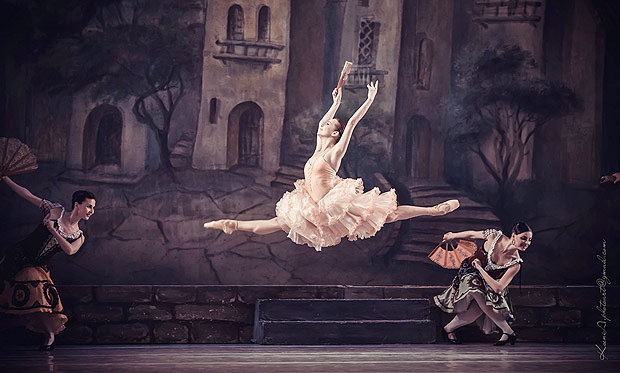
© Ksenia Orlova. (Click image for larger version)
Kateryna (Katja) Khaniukova, who has been dancing with English National Ballet these last 15 months, returned home to the company where she was a much loved principal dancer – Kiev Ballet. Graham Watts reports on the night and ballet in a country at war…
Kiev Ballet (National Ballet of Ukraine)
Don Quixote
Kiev, National Opera House
5 June 2015
www.opera.com.ua
Ballet enjoys significant popularity in the Ukraine and the Kiev State Choreographic Institute – now run by Nobuhiro Terada – has produced some of the world’s leading dancers (Alina Cojocaru, Sergei Polunin, Denis Matvienko and Ivan Putrov to name but a few). Another recent export is 25 year-old Kateryna Khaniukova who joined English National Ballet in March 2014 – a Rojo recruit, sufficiently attracted by the ambition and inspiration of the company’s artistic director to relinquish the status of principal ballerina in her home city of Kiev, to become a junior soloist in London. As a first thought, it may seem odd for Khaniukova to have swapped this elite home status for a lower place in another company’s hierarchy but Tamara Rojo’s drawing power and the expanding repertoire of ENB is clearly worth the risk.
It is even more remarkable given that Khaniukova had no prior intention of leaving Kiev to dance elsewhere. During a brief visit to London, she was advised by her coach in Kiev – Alla Lagoda (also a former mentor to Cojocaru) – to take class while away, thus becoming a relatively unknown guest at ENB’s morning ritual. Her impeccable technique immediately attracted Rojo’s attention and the subsequent offer of a contract. The expressive quality of English ballet was a powerful incentive but the potential of working under Rojo was the decisive factor. “We had only seen her on DVD”, Khaniukova told me, “and so the opportunity to come and work with an artist of such dramatic quality was something that I just couldn’t miss. I wanted to absorb all those feelings into my work”.
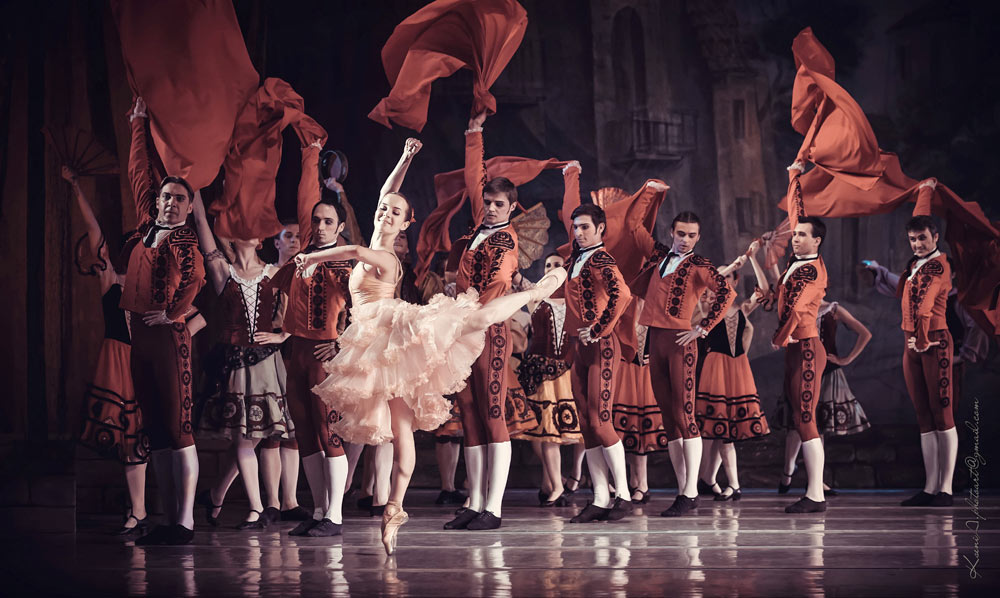
© Ksenia Orlova. (Click image for larger version)
Leaving the Ukraine permanently was not so easy. The Maidan Square Revolution erupted soon after her return and the visa centre was in the line of sniper fire. It took weeks to sort out the paperwork through all this chaos, during which time Khaniukova’s parents – both doctors – were tending to the Maidan’s victims. The requisite passport pages were eventually stamped and Kateryna (informally known as Katja) was able to join ENB, two months later than planned.
A cold night in February 2014 saw her farewell performance at the Kiev Opera House, given to a skeleton audience sheltering from the troubles outside. Just like Pavlova and others dancing on in St Petersburg through the 1905 Russian Revolution, Katja felt that “…dancing ballet seemed so pointless when people were dying on the streets a few hundred yards’ away”. Since the ballet being performed was The Nutcracker, the land of the sweets must have seemed a million miles away!
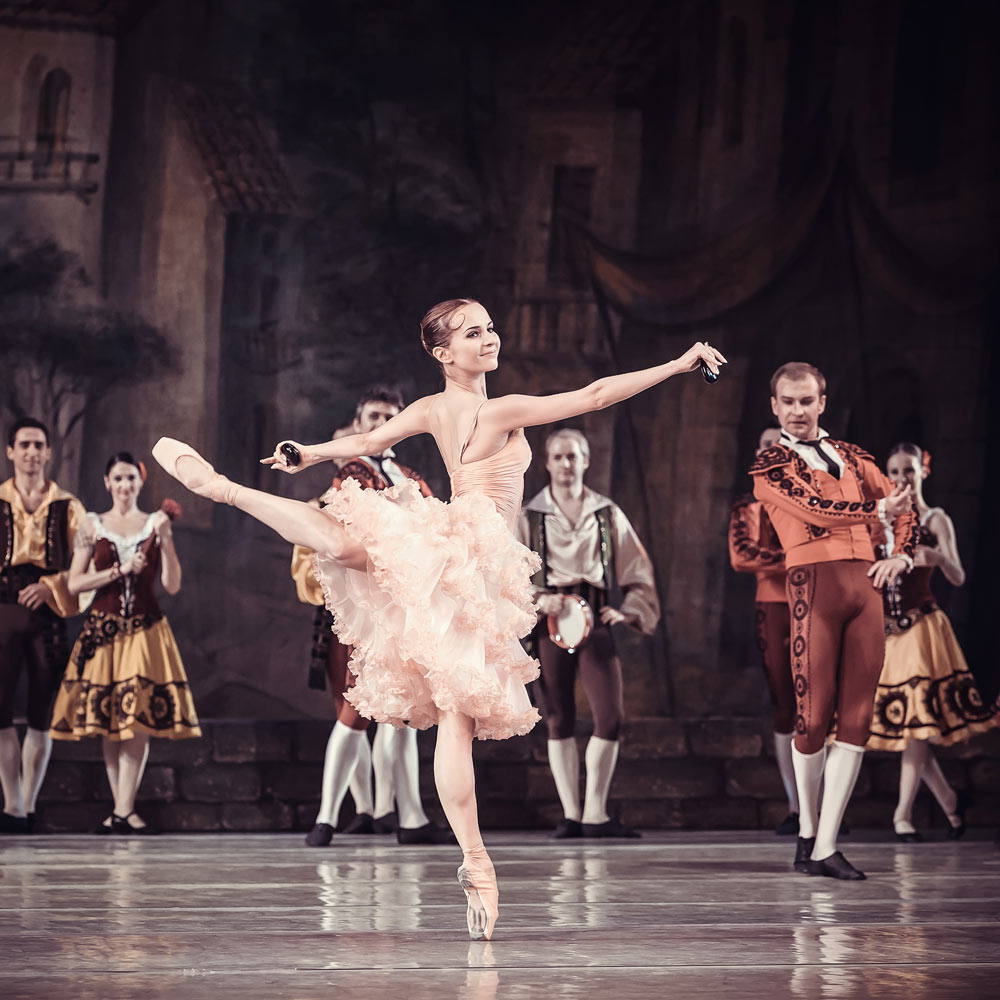
© Ksenia Orlova. (Click image for larger version)
What a difference in just 15 months! Khaniukova’s return to Kiev for a one-off performance of Don Quixote was accorded the glittering, red-carpet treatment of a major premiere. Fashion magazines were there to photograph the event; TV stations filmed it; a documentary film crew followed the ballerina wherever she went over the whole weekend. A “sold-out” theatre included an audience of politicians, journalists and assorted celebrities from the worlds of sport, film and the arts. It was an occasion that fully demonstrated the power of Ukrainians’ affection for an artist who had left to make a mark elsewhere; turning up in their droves to welcome Katja home.
The National Opera House of the Ukraine (named in honour of Taras Shevchenko) is a gorgeous – if slightly dishevelled – architectural gem, designed by Victor Schröter. A curved neo-renaissance exterior – the façade a neat double-height row of columns and porticos – sits under a domed roof topped off by impressive statuary; enclosing a classical interior, based on the Viennese model of the early 20th Century. As so often the case in Central European cities, this opera house replaced another that was consumed by fire (allegedly caused by a candle left alight after a performance of Eugene Onegin) and the new building on Volodymirska Street was opened in September 1901. The backstage areas and studios are spacious although in need of refurbishment and the public parts are a splendidly ornate warren of corridors and passageways with a surprise around every turn. Unnoticeable to most but key to those who perform there is a flaking, apparently uneven, wooden stage with a vicious rake.
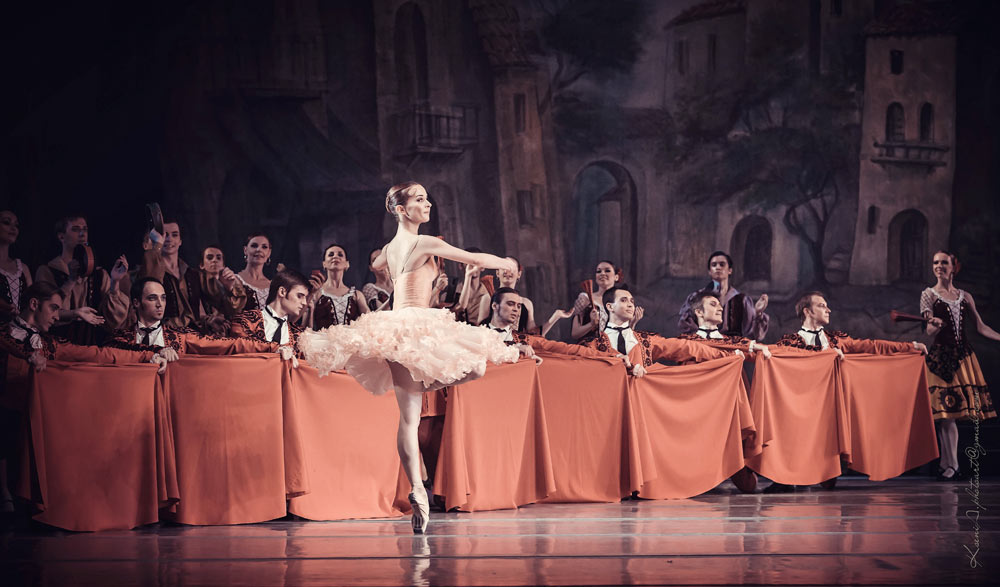
© Ksenia Orlova. (Click image for larger version)
The version of Don Quixote in the Kiev repertory is a typical hand-me-down interpretation of Gorsky’s 1900 revision of Petipa’s original 1869 ballet, seen through the prism of many further retouches through the years of the Soviet Union. It enjoys detailed painted – but generally dull – backcloths to represent generic scenography and vivid, decorative costumes (not least, the gorgeous crimson and black tutu with gold embroidery worn by Khaniukova’s Quiteria in the final act celebrations). In many ways, the design of this Don Quixote was a cipher for the opera house in which it played: both beautiful and decrepit; grand elegance slightly worn out by age. It would sit appropriately within a Venetian setting.
There are some additions to the traditional libretto including a gypsy pas de deux to music with which I am not familiar and is neither by Minkus or Drigo. The conductor – Herman Makarenko – told me that this addition was by a little-known soviet composer and had been added during the mid-twentieth century. He couldn’t remember the name but my guess is that it was composed by Vassily Soloviev-Sedoy for the Bolshoi’s production in 1940. Anyone with better information is welcome to comment below.
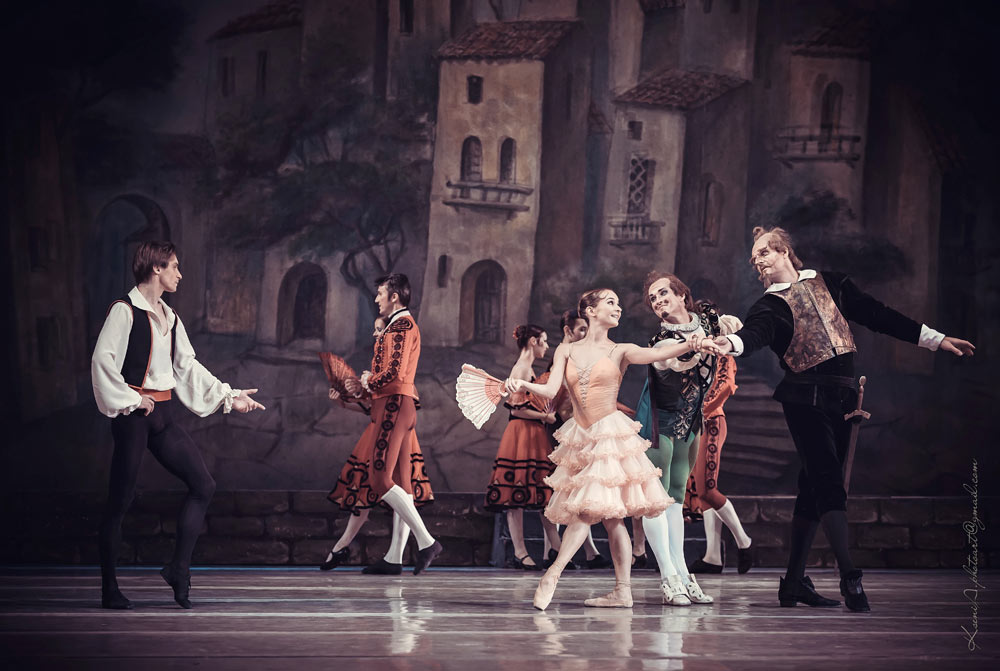
© Ksenia Orlova. (Click image for larger version)
The comic-book characterisations of the title character and his side-kick, Sancho Panza, were accomplished in broad-brush style, respectively by Sergei Litvinenko and Nikita Sokolov. The latter is a fine name for this ballet since it was another Sokolov (Sergey) on whom the very first Basil was created in the premiere of Petipa’s ballet at the Bolshoi in 1869 (and incidentally, he was also Swan Lake’s first-ever Rothbart) Litvinenko was a most appropriate, tall and lanky, tourist-book evocation of the wandering, chivalrous knight. If in need of another job he could become a Don Q look-alike around the arid plains of Castilla La Mancha (where only a week previously, by coincidence, I visited the tiny village of Santa Quiteria and met a matador!)
Elsewhere in the cast, I was taken by fiery performances from another Kateryna (Kurchenko) as the Street Dancer and the vivacious Mercedes of Ksenia Novikova; plus a gypsy solo with swirling red skirt and elastic spine from another Ksenia (Ivanenko). Maxim Kamishev was a haughty Espada (known as Esparto in the Ukraine); Irina Borisova brought regal elegance to the Queen of the Dryads; and yet another Kateryna (Kalchenko) was ethereally fleet-footed and busy as the Cupid. One overriding impression that remained with me throughout the ballet was of ultra soft landings on this hard uncompromising stage. All the dancers’ jumps were generally high and long, yet their landings were largely silent.

© Ksenia Orlova. (Click image for larger version)
Khaniukova was reunited with her former dance partner, Viktor Ishchuk, who graduated into the Kiev company in 2001. He is ideally cast as Basil, the carefree but indigent barber of Barcelona. In a modern adaption he might suit being a skater boy since Ishchuk has that quality of naturalistic, blithe and buoyant chirpiness. He is a dancer with the prodigious virtuoso skills required for Basil but there’s also a charming “devil-may-care” dishevelment around the edges.
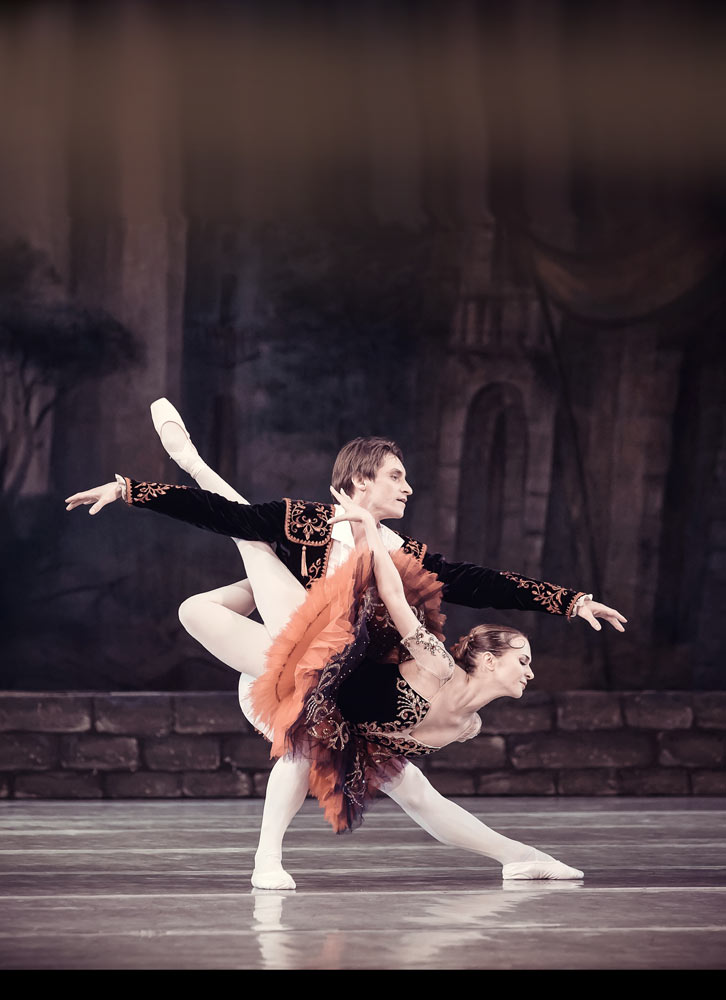
© Ksenia Orlova. (Click image for larger version)
Khaniukova’s Quiteria is a delicately-framed but ebullient minx. As merited by the special circumstances of this show, she was truly a divinity returned from exile. An adoring audience lapped up every second of her return, beginning with that gleeful opening solo in the Barcelona marketplace. By the time of her fast terre-a-terre entry to the harp accompaniment in the final act variation, Khaniukova had the whole audience clapping along with every step; not something I have experienced many times before.
Few ballerinas have an entire armoury of elite skills but Khaniukova seems without any weakness. She spins and jumps strongly (her jeté is an object of marvel), possesses an intuitive musicality, extraordinary flexibility, graceful port de bras and épaulement; and she gilds the lily by capturing the romantic, comedic and Machiavellian essences of Quiteria with exquisite, expressive acting. It was a performance perfectly pitched to the gala occasion of her homecoming. Remarkably, she and Ishchuk managed to rise above having almost no time to rehearse together, holding it all together securely through their collective body memories. It was only when Khaniukova was required to dance in harmony with Borisova and Kalchenko during the dream scene that any lack of rehearsal was detectible.

© Ksenia Orlova. (Click image for larger version)
Don Quixote is such an anomaly in the classical ballet repertoire. The performer in the title role never dances and is merely a supporting character artist; it is an adaption that bears almost no narrative relation to the original novel; a rare example of a comedy amongst a horde of nineteenth century melodramas and tragedies and an even rarer example of a ballet being named after a man and not the leading female.
The layered contributions from Petipa and Gorsky in versions that went back and forth between Moscow and St Petersburg have left us with the best of both worlds in Eastern European stagings that have followed – including this archetypical production in Kiev – with comedic fun, pantomime characterisations and – most especially – the opportunity to see state-of-the-art ballet technique, expertly performed.
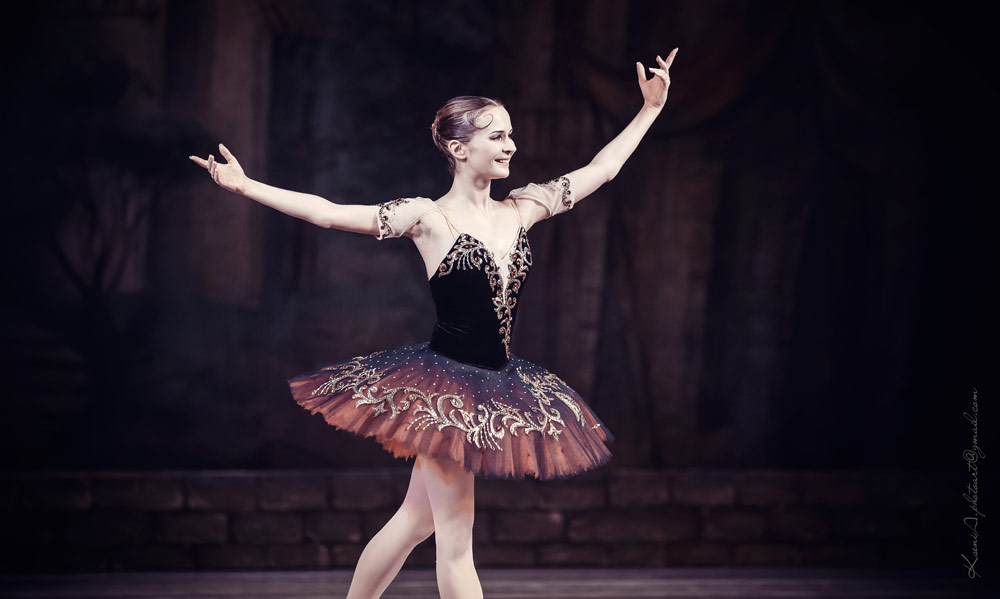
© Ksenia Orlova. (Click image for larger version)
One might add that Don Quixote is a ballet of hope, best represented by the title character’s chivalric quest for honour and a happy ending. In that sense it seemed very appropriate to the current situation in the Ukraine, a country under threat from its eastern borders. The notion of honour and a happy ending are especially relevant to their troubles of today.
In addition to this excellent gala performance, my weekend in Kiev included a tour of the Kiev Ballet School, meeting legendary teachers (such as the octogenarian, Vladimir Denisenko) and watching an awed class of young dancers receive a signed pair of Tamara Rojo’s pointe shoes. Kiev has a second fully-fledged opera house with a full-scale ballet company, which rejoices in the wholesome title of the Kiev Municipal Academic Opera and Ballet Theater for Children and Youth. Walking past the theatre on Mezhyhirsta Street on Saturday afternoon, my charming guide suddenly disappeared inside and – within seconds – I found myself being ushered into the central box to see the final act of Valeriy Koftun’s Cinderella, which had dancing of a decent, professional standard. An opera house just for kids – no wonder culture thrives in the Ukraine!











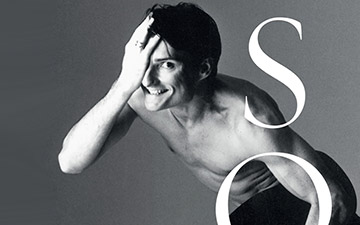


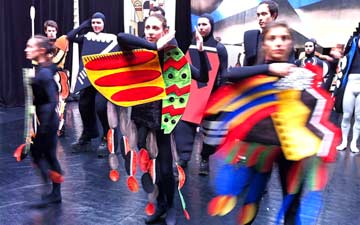
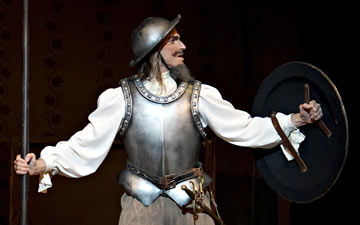

You must be logged in to post a comment.